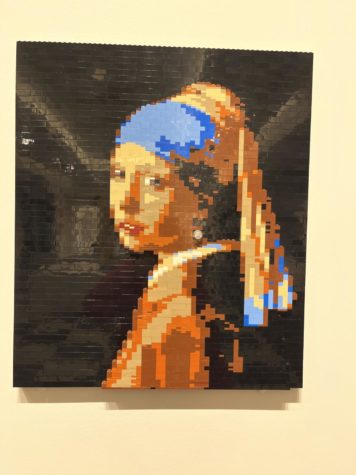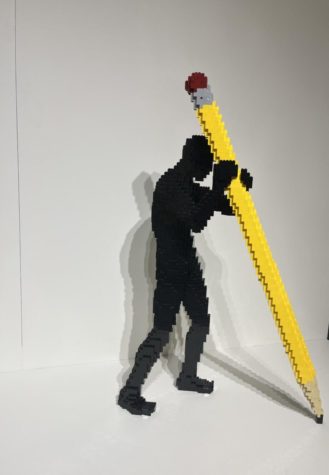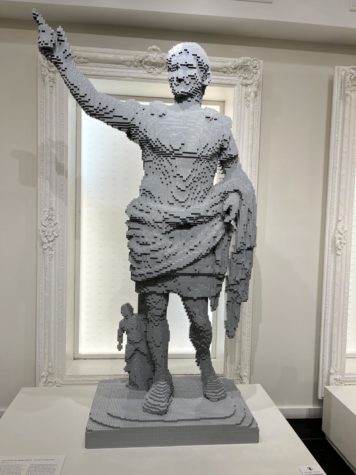Ordinary Hobby, Extraordinary Career: Nathan Sawaya’s The Art of the Lego Brick
Sawaya’s original sculpture “Untitled (Fist)”

Nathan Sawaya’s childhood pastime was not extraordinary, he played with Legos. As an adult, his career initially had nothing to do with his childhood hobby. He worked as a securities lawyer in New York City.
Yet, Sawaya would come home from the office needing to do a creative activity. In the beginning, he drew and painted. But one day, he thought about creating a sculpture from the Lego bricks he used as a child. He had seen statues made of other materials, but never Legos.
“When you look at my sculptures up close, you see all those sharp corners and right angles, and then when you back away from it, you see curves. That’s the magic of using Legos,” Sawaya said.
His experiment with Legos worked. Sawaya created an online gallery of all his work and started receiving requests for statues. While working as a lawyer, Sawaya worked on commissions too.

“It was not an overnight decision as much as Hollywood wants to make it out to be. It was not just that I had this thought one day like you see in movies. For me, I had to plan it,” Sawaya said.
Two years after creating his first Lego sculptures, Sawaya quit being a lawyer. His family supported his decision, but not all of his colleagues understood his choice.
“Some of my colleagues were negative, and they thought that I was making a mistake because I was leaving a high-profile job [to go] play with toys,” Sawaya said.
Still, after seeing that there was a market for his art, Sawaya became a full-time artist using Legos. He still faced challenges explaining to galleries what his art was.

“Galleries actually kind of laughed at me because they thought Lego art was like a little train,” Sawaya explained.
Today, Sawaya’s exhibit, The Art of the Lego Brick, has been showcased at galleries all over the world. His exhibit in Boston, on Newton Street, consists of over 70 sculptures using over 1,000,000 Lego bricks.
He created versions of Leonardo da Vinci’s “Mona Lisa” and Johannes Vermeer’s “Girl with a Pearl Earring” from Legos. He has made 1:1 scale replicas of Roman statues, like “Augustus of Prima Porta,” using Legos. The Lego paintings use around 4,000 bricks, while the larger sculptures use over 20,000 bricks.
In addition to recreations, Sawaya creates original sculptures entirely from Legos. One piece that resonates with viewers is “Yellow,” a sculpture of Sawaya ripping his chest while Legos spill out of it.

The same Legos that you played with as a child and stepped on when you got older is what Sawaya uses. The art is composed of the standard Lego pieces purchased from the Dutch manufacturer. Sawaya does not manipulate the colors or alter the bricks in any way. The strict adherence to these rules makes his art form more accessible.
Sawaya explains that if someone visits a museum and sees a stone statue, they can appreciate it, but they cannot create something similar at home. Also, creating a stone statue requires a skill set that most people do not already have. However, Sawaya’s use of Legos as a medium of art removes this barrier.
“My hope is that if you’re inspired by this exhibition made out of Lego art, maybe you go home and grab a few Lego bricks and you build a little something for yourself,” Sawaya said.

Sawaya’s inspiration for his sculptures usually comes from his walks around New York City. He comes back to his studio with an idea for a new piece. To create a sculpture, Sawaya needs to visualize the piece first. Sometimes that requires creating an initial sketch. While building an 80,020-piece T-rex sculpture, Sawaya stared at a miniature model in his studio.
Sawaya has been using Legos to make art for over 15 years. His advice for those who want a less typical job is to take the lessons first.
“Just because you are mad and you want to play the violin instead of a nine-to-five job, you can’t just quit. You have to take the time to take the violin lessons first,” Sawaya said.


